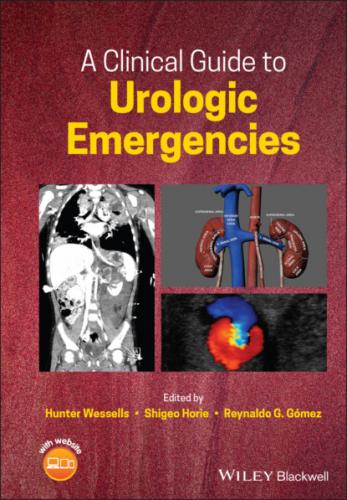A Clinical Guide to Urologic Emergencies. Группа авторов
an excess burden of disease due to war, cyclic violence, road traffic injuries, and diseases for which access to emergency care is essential.
Population growth worldwide, changing epidemiology of disease, and human migration and displacement will exacerbate emergency urological needs across the lifespan and across the spectrum of global wealth. For healthcare providers in high income countries (HIC), motor vehicle collisions, obstructing urinary calculi, urinary tract infections (UTI), and the cumulative burden of urological diseases associated with aging and comorbid chronic disease such as diabetes and cardiovascular disease will drive urgent and emergent healthcare utilization. Urological surgery to improve health in low and middle‐income countries (LMIC) has a critical focus on the broader impact of road traffic accidents, urethral stricture, advanced benign prostatic obstruction and genitourinary infections. The Lancet Commission on Global Surgery achieved consensus that HIC actors should work in equal partnership with LMIC actors and should situate efforts to improve the delivery of surgical care within the broader health systems strengthening agenda.
The editors have collaborated to present a global perspective, encompassing a diversity of healthcare environments, patient populations, and authors to ensure that the content of this book will be relevant to the widest range of healthcare providers. Acknowledging that not all urological care can or should be delivered by urologists, we provide detailed information for first‐line providers in urgent care, emergency, and office‐based settings. Where indicated we call out alternative laboratory testing, imaging, and treatments for situations in which resources preclude the use of technology intensive and costly choices. Similarly, the publisher has aimed to provide a low‐cost textbook with digital imprint to ensure wide accessibility.
We organized the content by organ systems, allowing the reader to go from “top to bottom” of the genitourinary system, or cut to the chase and find a specific chapter as a point of reference. An important feature incorporates perspectives on traumatic injuries from the civilian and military environments. Unfortunately, war and road traffic will place increasing burdens on civilian populations and healthcare systems. Thus, the inclusion of military and civilian perspectives allows for innovation, cross pollination, and preparedness. The burden of congenital anomalies cannot be eradicated and will require surgical and non‐surgical interventions across decades of a person’s life; early treatment can have enormous benefit and thus we include a chapter on neonatal emergencies.
Completing this book in the midst of a global pandemic, it is important to recognize that diagnosis and treatment of many urological conditions will be deferred because of limited access to routine care, surgery, and even emergency services. The frequency of extreme weather events, resource scarcity, and other factors will likely lead to other severe disease outbreaks that will further limit access to care and drive greater pressure on emergency urological services. Thus, it is instructive to estimate the burden of the COVID‐19 toll of deferred urological problems, which will come to the fore as pressure eases on ICU and Emergency Departments worldwide. We have added a special chapter on the topic.
References
1 http://www.healthdata.org/gbd/about
2 Ng‐Kamstra JS, Greenberg SLM, Abdullah F, et al. Global Surgery 2030: a roadmap for high income country actors. BMJ Glob Health. 2016; 1(1): e000011.
3 https://www.brookings.edu/research/the‐climate‐crisis‐migration‐and‐refugees/
About the Companion Website
This title is accompanied by a website:
www.wiley.com/go/wessells/urologic
The website contains key videos related to the following chapters in the book:
Chapter 2. CT scan of penetrating renal injury
Chapter 4. Ureteroscopic stone treatment (laser lithotripsy and basket extraction)
Chapter 6. Robotic ureteral reconstruction with buccal mucosa graft
Chapter 9. Urethral elongation after pelvic fracture urethral injury
Chapter 9. Urethral disruption after pelvic fracture urethral injury
Chapter 9. Endoscopic urethral realignment after pelvic fracture urethral injury
Chapter 10. Excision and primary anastomosis of bulbar urethral stricture
Chapter 11. Transurethral drainage of prostatic abscess
1 Blunt Renal Injuries
Lindsay A. Hampson and Nnenaya Mmonu
Department of Urology, UCSF School of Medicine, San Francisco, CA, USA
Epidemiology, Etiology, Pathophysiology
Epidemiology and Etiology
Kidneys are the most injured genitourinary organ in external trauma, and it is estimated that 1–5% of all traumas and 10% of abdominal traumas sustain a renal injury [1–4]. In a series consisting purely of blunt abdominal trauma mechanism, 15% of patients were found to have an injury to the kidneys [5]. Of all patients who sustain genitourinary trauma, over half of them involve the kidney [6]. A population‐based study found the incidence of renal trauma to be 4.9 per 100 000 population ≥16 years of age in the United States [4]. The majority of these patients were young and male, with 72% between the ages of 16 and 44 and 75% male. In an analysis of pediatric genitourinary injuries, renal injuries were found to make up 3.5% of the cohort, but the incidence has not been defined [7].
There is variation in the etiology of renal trauma based on geographical location; series from Low and Middle‐Income Countries (LMIC) suggest that the rates of penetrating trauma are high, with the majority of blunt trauma caused by road traffic accidents, assault, and falls [8–11]. In the More Economically Developed Countries (MEDC), the vast majority (90–95%) of renal injury is sustained by blunt trauma, which is caused by motor vehicle collisions (63%), falls (14%), sports injuries (11%), pedestrian accidents (4%), motorcycle crashes (2%), assault (2%), and the remaining from other causes [6, 12, 13]. In a recent blunt renal trauma series, 80% of injuries were found to be grade I–II renal injuries, 9.5% grade III, 8.1% grade IV, and 2.7% grade IV [5]. Thus, imaging all renal injuries is unnecessary, and criteria have been developed (see below). Table 1.1 summarizes the large (n > 100) series with emphasis on blunt injuries.
Table 1.1 Demographics of renal trauma.
| SERIES a | [6] | [14] | [15] | [1] b | [4] | [16] | [5] b |
|
|---|
